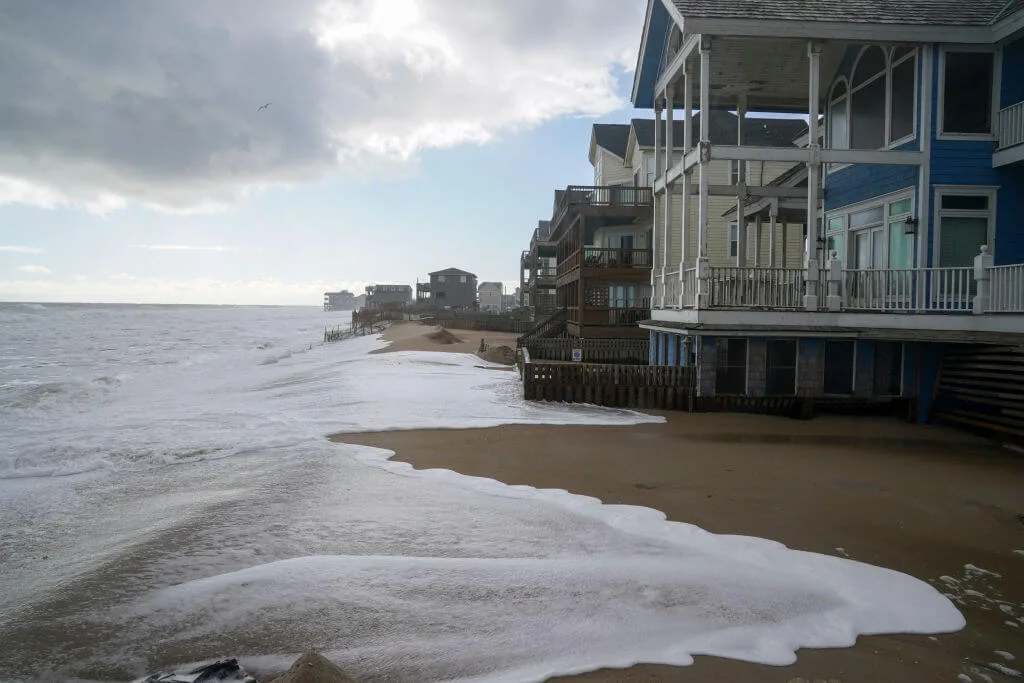
Erosion is a direct and immediate threat to many of North Carolina's coastal towns, including Rodanthe, seen here in December, 2022. (Photo by Jahi Chikwendiu/The Washington Post via Getty Images)
A new report warns that while progress has been made, it is not enough to ensure a “livable and sustainable future.” And you don’t have to look outside North Carolina to see the dangers.
We’re running out of metaphors.
The world is facing a “climate time bomb,” and there are only seconds left on the clock.
The world is hurtling toward a cliff and will soon crash through the point of no return.
The ice is thinning and the cracks are spreading beneath our feet.
Choose the one that works best for you, but know that all are true.
The UN released its 2023 Climate report this week, the definitive account of what’s happening, what needs to be done to avoid cataclysm, and what will happen if we don’t. It’s not much different than last year’s report or the one before that, it’s just more urgent. And those others were plenty urgent.
(Here’s a link to our story on last year’s report, which said essentially the same thing as this year’s.)
The world is not doing enough to avoid global warming thresholds that will make life unlivable for huge portions of the globe, the report, written by more than 250 climate scientists across the globe, says. That first threshold is about seven years away.
“There is a rapidly closing window,” the report states, “to secure a livable and sustainable future for all.”
The effects of human caused climate change are here, right now. That’s indisputable. Just as indisputable is that bad can very quickly become very bad which can then become cataclysmic.
The good news is that the world has indeed shown an increased effort to lower its greenhouse emissions, the report says. (North Carolina alone has made significant moves to limit its emissions along the recommended track.) And the world knows what to do and has the resources to do it.
While the worst effects may not be felt everywhere in equal measure at the same time, there would be no escape from the effects of increased drought, flooding, hunger, heatwaves, crop failures, extinctions, and shortages of food and drinkable water if the world does not act.
You don’t have to look beyond North Carolina to see the danger.
As the Washington Post recently highlighted in Rodanthe, “severe erosion is [already] upending life, forcing hard choices and offering a glimpse of the dilemmas other coastal communities will face.”
There is no doubt that saving the world from climate disaster will be expensive, but the cost is nothing compared to the price of inaction, these reports – and really every report for the last twenty years – says.
Climate-related disasters in North Carolina have amounted to between $50 billion and $100 billion in damages since 1980. And those costs often fall on people least likely to afford them.
The reports estimate with very high confidence that the money currently being spent on fixing the problem is three to six times less than what is needed.
Politics

Trump NC fundraiser co-host runs an alleged MLM
Even though less than 1% of MLM participants make a profit, the National Agents Alliance tries to recruit by promising life-changing experiences,...

VIDEO: Biden Wants to Guarentee Affordable Care for Children, Seniors, and the Disabled
View this post on Instagram A post shared by Cardinal & Pine (@cardinalandpine) President Biden’s proposed budget would...
Local News

The zodiac signs of 12 iconic women offer insight into their historic accomplishments
Zodiac signs can tell you a lot about someone’s personality. Whether they’re an earth, water, air, or fire sign, these 12 categories (which are...

VIDEO: Two men rescued off Beaufort, NC
https://www.tiktok.com/@cardinalandpine/video/7353300192906562859?lang=en WATCH: We love our Coasties in NC! ⚓️ When a boat ran aground off of...





